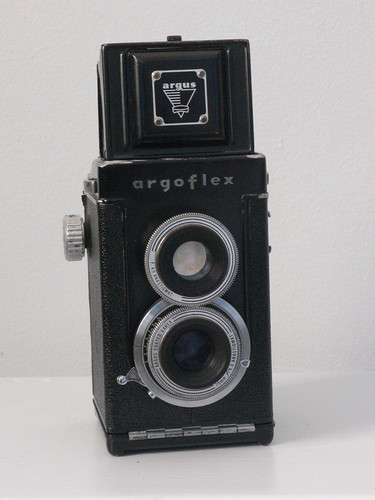Argus Argoflex EF
| Argus Argoflex EF |
|---|
|
Manufacturer: Argus
Film type: 620
|
The Argoflex EF was a TLR made by Argus from 1948-1951. It takes 6x6 centimeter exposures on 620 rollfilm and had an aperture range of 4.5 to 18. Unlike its predecessor, the bakelite Argoflex E, the body was made of metal and had a hot shoe for flash. Also unlike the early-production E, it cannot accept 120 at all, as the narrower 620 spools are already a snug fit within the compartments, making it impossible to load the slightly wider 120 spools. Due to the numbers produced and the entry-level quality, it is still quite possible to find the various true-TLR Argoflexes cheaper than almost any other TLR.
The camera is physically quite substantial, with a cast-metal construction overlaid with leatherette. It possesses very clean lines due to the lack of complicating controls; except for the film advance, every control is on the taking lens body. The lenses are both coated Varex three-element anastigmat f/4.5, and are synchronized with external gearing. Thus it is one of the few twin-lens reflex cameras with lenses of equal quality for the taking and viewing lenses; most TLR viewfinders were built around a lower quality lens with similar focusing characteristics to the taking lens. On top of the view-finding lens barrel is a comprehensive depth-of-field calculator that shows the current focus range for each of the f-stops (or rather, each of the labeled f-stops, as the diaphragm can be set between the stops shown.) On the rear of the camera is the red window, placed for 6x6 square exposures. This is covered with a pivoting guard inside the camera, operated by a small lever below the window. Presumably this is so that, if the camera is left in the sun, the light filtering through the backing paper will not eventually fog the film.
The shutter is a Wollensack Alphax, a fairly reliable leaf shutter with a speed range of 1/10 - 1/200s plus time exposure and bulb. This is an everset shutter with a rather long throw. The camera possesses flash-sync, but unfortunately the modern photographer will find it impossible to mount a flash. The hot shoe is proprietary; it requires a thinner flange on the flash than a modern unit will have, and the contacts will almost certainly not line up. Add to this that the pseudo-PC socket is not compatible with a real PC cable, and it becomes clear that only an Argus flashgun or a very cunningly devised substitute will function with this camera. Whether a modern flash can somehow be connected with a homemade adapter is a question for the ages.
The viewfinder is rather basic, being slightly dim in the best lighting conditions and almost invisible in subdued light or with strong light overhead. The camera does, fortunately, possess a sports finder for quicker composition. This frame finder is formed by erecting the viewfinder hood and pressing the front plate with the Argus logo to fold it back over the viewing screen, revealing a large window in the front of the hood. The plate will catch on two catches on the back plate of the hood, just below a small peep-hole which forms the rear of the finder. There is also a folding loupe to assist in focusing using the reflex finder, though the shape of the magnifying lens rather necessitates the photographer to put his or her eye right up to the top of the camera to see a clear image through it.
